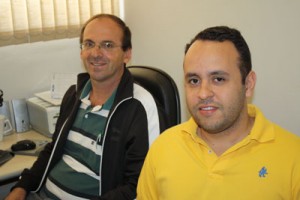
Luís Fernando da Silva is the winner of the 2014 award for best thesis in the field of Materials, granted by the Brazil´s Federal Agency for the Support and Evaluation of Graduate Education (CAPES). Luís Fernando´s Doctoral thesis, “Synthesis and characterization of SrTiO3 and SrTi1-xFexO3 compounds prepared by microwave-assisted hydrothermal method”, was defended in 2013 in the São Carlos School of Engineering at University of São Paulo (USP). The research was advised by Professor Valmor Roberto Mastelaro.
The result of the Capes Award 2014 was released in early October. The award ceremony will be held on December 10, 2014, in Brasília.
Read our interview with Luís Fernando.
SBPMat Newsletter: – Could you tell us briefly about how your interest in science started, and what were the most important moments in your academic career so far?
Luís Fernando da Silva: – My interest started during my undergraduate studies in Physics at the São Paulo State University (UNESP) at Bauru. I entered the research initiation program in my second year, and my project comprised the structural characterization of GaAs and GaN film, having Professor José Humberto Dias da Silva as my advisor, and receiving funds from the São Paulo Research Foundation (FAPESP). During my last undergraduate year, my work received an honorable mention in the USP research initiation symposium, which managed to motivate me further to enroll in a Master’s program in the field of Materials. Due to my interest in structural characterization, I started my Master’s studies at USP being advised by Professor Valmor R. Mastelaro, who is a reference nationwide in the field of X-ray absorption spectroscopy. My work consisted in preparing and characterizing amorphous and nanocrystalline StTiO3 and SrTi1-xFexO3 compounds. By the end of my Master’s studies, Professor Valmor Mastelaro proposed the challenge of synthesizing the SrTi1-xFexO3 compound using the hydrothermal-microwave method, considering that, up to that point, there was no record of its preparation by means of such method. After studying different parameters of its synthesis and characterizing the structural properties of the SrTiO3 compound, we started synthesizing the SrTi1-xFexO3, which we managed to do with great success. Both compounds were characterized using X-ray absorption spectroscopy (XANES and EXAFS) at the National Synchrotron Light Laboratory (LNLS), and the importance and originality of the results were accepted to be published by major journals in the field of materials: CrystEngComm (CrystEngComm, 2012,14, 4068-4073) and Physical Chemistry Chemical Physics (Phys. Chem. Chem. Phys., 2013,15, 12386-12393). In addition to that, according to the literature, the SrTi1-xFex03 compound has been successfully applied as a gar sensor, mainly for hydrocarbons and oxygen. Based on this application, Professor Valmor Mastelaro established a partnership with the microsensors group from Aix-Marseille University, in the city of Marseille, France. Thanks to said partnership, I received a scholarship to join the microsensors group for six months, counting with funds from the “Ciência Sem Fronteiras” (Science without borders) program. The results obtained were partially released by an important journal in the gas field, Sensors and Actuators B (Sens. Actuators, B, 2013, 181, 919–924). Currently in my Postdoctoral studies, I started a new research project, advised by Professor Elson Longo, in a partnership with Doctor Cauê Ribeiro from the instrumentation unit of the Brazilian Corporation of Agricultural Research (Embrapa), which comprises the study of photoactivated resistive gas sensors. Recently, I was granted a project to develop said research.
SBPMat Newsletter: – Why did you start to do research in the field of Materials?
Luís Fernando da Silva: – The field of Materials always fascinated me, since the time I spent in the research initiation program. The possibility of managing to synthesize a material, unveil its properties and use it for a technological application is challenging and fascinating at the same time.
SBPMat Newsletter: – In your opinion, what is the main contribution of your award-winning thesis?
Luís Fernando da Silva: – The main contribution of my thesis was the use of the x-ray absorption spectroscopy technique. The vast majority of existing articles in the literature report the method used to prepare the material and its application (gas sensor, photocatalysis, etc); however, there are only a few studies on its structural properties, restricted to the identification of the crystalline phases using the technique of x-ray diffraction. In my work, we could observe that materials (in my case, SrTiO3 and SrTi1-xFexO3) prepared using the hydrothermal-microwaves method, present substantial structural distortions. In addition to that, concerning the SrTi1-xFexO3 compound, we managed to analyze its detection properties against different gases (reductant and oxidant) in greater detail, since one of the most important parameters for a gas sensor is its selectivity.
SBPMat Newsletter: – What were the criteria that guided you to do a research recognized nationwide for its quality (the award-winning thesis)? To what factors do you attribute such achievement?
Luís Fernando da Silva: – Mainly my good relationship with the Doctoral advisor, Professor Valmor R. Mastelato, who gave me total freedom and credibility to develop this work, as well as important scientific contributions. Besides that, the infrastructure of the Center for the Development of Multifunctional Materials (CDMF/FAPESP) was crucial and allowed a proper and detailed characterization of the compounds studied in the thesis.
SBPMat Newsletter: – Would you like to leave a message for our readers who are doing research in undergraduate, master´s or doctoral level in the field of Materials?
Luís Fernando da Silva: – I believe that the main message is that before starting any research work (whether for initiation, master’s or doctoral studies), it is paramount for them to have pleasure doing their research and believe in the potential and quality of their work. If you believe the work you are developing has potential, you will seek your best to do it.
